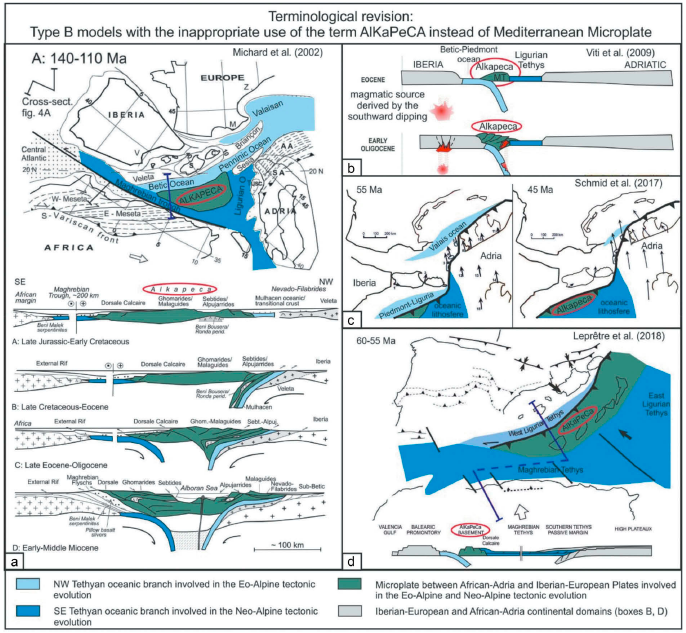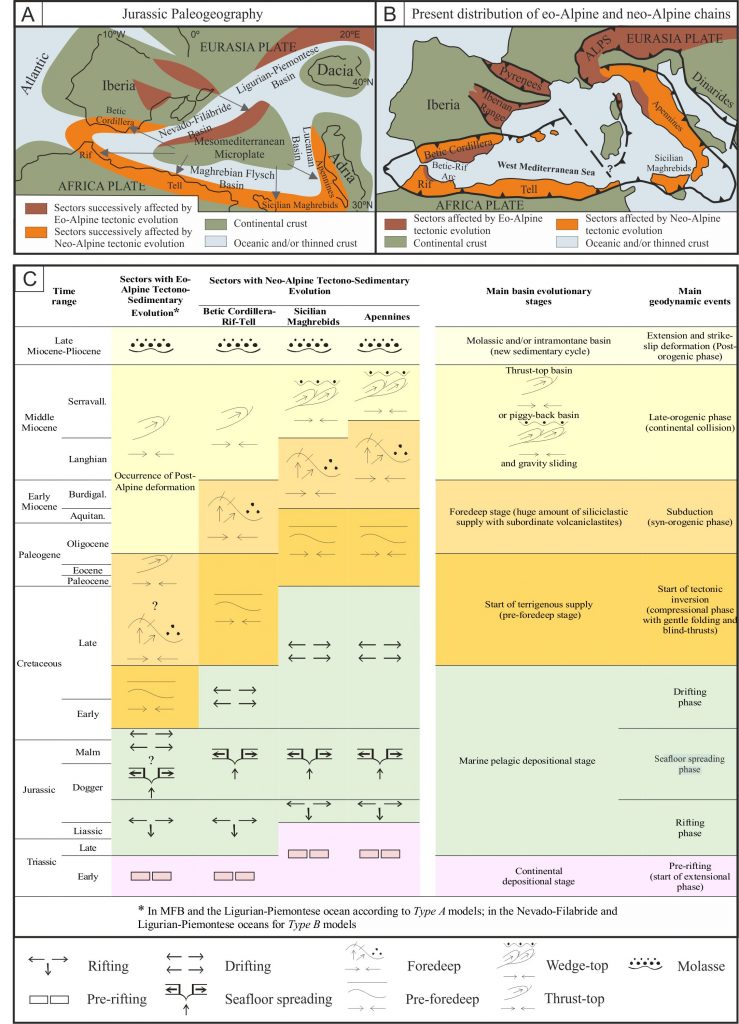Home » Posts tagged 'Microplates'
Tag Archives: Microplates
Terminology revision of AlKaPeCa and Mesomediterranean Microplate
The use of terms strictly related to the original formulation of different models caused, in some cases, inaccuracies in the univocal identification of some main palaeogeographic elements.
Bouillin et al. (1986) introduced the acronym AlKaPeCa for a lithospherical block formed by Alboran-Kabylian-Peloritan-Calabrian Internal Zones, Alpine units. According to them the relationships between AlKaPeCa and the Maghrebian Flysch Basin may be synthesized as follows:‘ the only possible oceanic zone known between Western Europe and Africa, at the Jurassic time, corresponds to the basement of the Flyschs which was located southward of AlKaPeCa’ .
Many palaeogeographic interpretations of the Jurassic-Cretaceous evolution of the Betic, Maghrebian and Apennine Chains have been roughly grouped into two main general families: (1) Type A models: they state the presence of a single oceanic area (i.e., the Tethys) located between the African and European Plates; (2) Type B models: they consider the occurrence of two oceanic branches of the Tethys surrounding one or more microcontinents located between the African and European Plates. Both classes of models imply a different evolution during the Pangea breakup and during the Cretaceous-Cenozoic convergence. According to Type A models the Pangea broke with a single oceanic branch located between Europe and Africa, meanwhile according to Type B models the fragmentation was more complex leading to two oceanic branches with several microplates located between Europe and Africa.

According to Guerrera et al. (2019) the original meaning of AlKaPeCa should be reserved to indicate a detached piece of the European Margin while the Mesomediterranean Microplate should be used exclusively for the independent microplate even though during the Maghrebian- Apennine orogeny these elements actually coincide to form the Internal Zones of these chains. For this reason, the use of this acronym is not appropriate for models which consider the occurrence of an independent microplate surrounded by different oceanic branches of the Tethys since Mesozoic. A more common name used in literature for this microplate is the Mesomediterranean Microplate.
Evolutionary geological models of the central-western peri-Mediterranean chains
Two main groups of geological models presented over the last four decades on the paleogeographic, paleotectonic and geodynamic eo-Alpine and neo-Alpine evolution of the central-western Mediterranean area were compared. The comparison was carried out mainly considering the main stratigraphic, sedimentological, petrographic, structural and plate tectonic constraints. Moreover, recent geophysical interpretations and reconstructions were also considered with an aim of presenting all the different results. The models can roughly be grouped into two main classes. First family considers the presence of the Mesozoic Tethyan Ocean, where a single oceanic basin is located between Africa and Europe and from which both eo-Alpine and neo-Alpine chains were generated during the Cretaceous to Miocene time span. Conversely, the other class considers the occurrence of at least two Tethyan oceanic branches (or with thinned continental crust) since the Jurassic, separated by one or more microcontinents. The pros and cons of both classes of models are presented. Progressive innovations and improvements to the two groups of models were proposed over the years. However, because the modelsare based on different data sets resulting from basic geological studies or obtained by means of other approaches, they often do not integrate easily.This caused interpretative difficulties and terminological uncertainties for their comparison, and completely different models were considered equivalent and, sometimes, the same terminology was used indifferently to identify different geological subjects. The main differences between the examined models concern the kinematic reconstructions and by hence in the paleogeographic and paleotectonic interpretations. The discussion presented in this paper aims at contributing to clarify and update the state of knowledge on this controversial topic.

Recent Comments